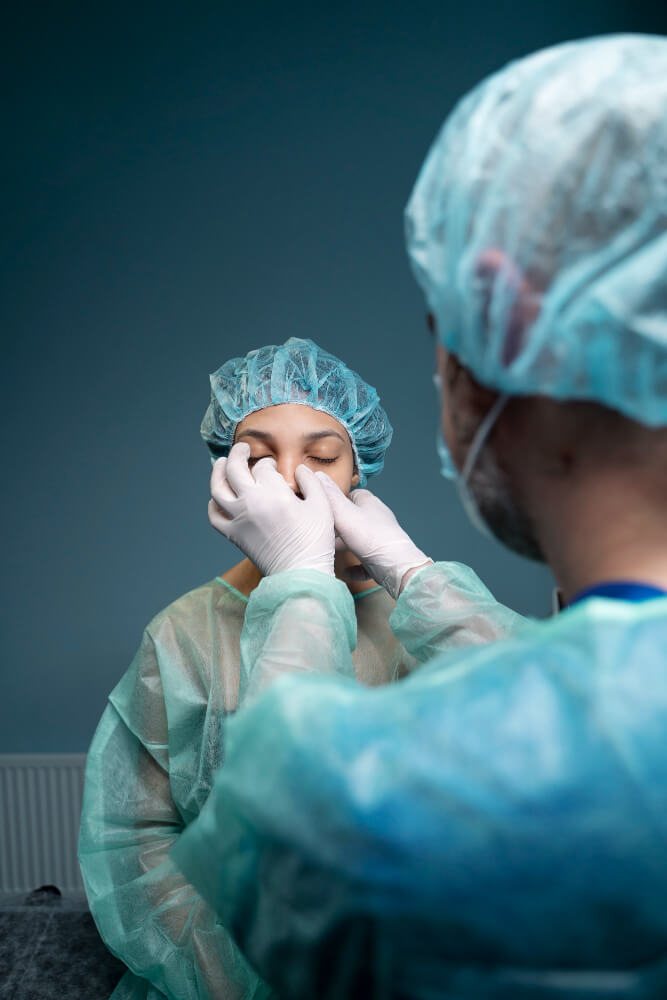Endoscopic Sinus Surgery Bellevue
Endoscopic Sinus Surgery Bellevue
Sinus infections may seem minor at first, but for some, they evolve into chronic, disruptive conditions that no nasal spray or home remedy can relieve. That’s where endoscopic sinus surgery (ESS) comes in.
Offered by Dr. David Santos at Sinusitis In Seattle, ESS provides effective, long-term relief with no external incisions and a quick recovery. Whether you live in downtown Bellevue, Clyde Hill, or nearby neighborhoods, expert sinus care is just a short drive away.
What is Endoscopic Sinus Surgery?
Endoscopic sinus surgery is a minimally invasive procedure that uses slim, fiber‑optic cameras (endoscopes) and specially designed micro‑instruments to restore normal drainage pathways inside the paranasal sinuses.
Through the natural nostril opening, without any external cuts, Dr. Santos removes obstructive tissue such as swollen mucosa, scar tissue, or nasal polyps. He can also correct structural problems like a deviated septum or narrow sinus openings. By re‑establishing unobstructed airflow and mucus clearance, ESS relieves pain, pressure, and infection cycles while preserving healthy tissue and facial appearance.


Ideal Candidates for Endoscopic Sinus Surgery
You may be a good candidate for endoscopic sinus surgery if you have:
- Chronic sinusitis lasting 12 weeks or longer despite antibiotics, nasal steroids, or allergy therapy
- Recurrent acute sinus infections—four or more in a 12‑month period
- Nasal polyps causing obstruction or loss of smell
- Fungal sinus disease
- Mucoceles, cerebrospinal fluid leaks, or benign tumors
- A deviated septum or concha bullosa contributing to blockage
- Asthma or aspirin‑exacerbated respiratory disease (AERD) with nasal polyposis
During your consultation, Dr. Santos conducts nasal endoscopy, CT imaging, and allergy assessment to confirm that surgery—not additional medical therapy—offers the best path to lasting relief.
Request an Appointment
Benefits of Endoscopic Sinus Surgery
- No external scars: Everything is performed through the nostrils.
- Less post‑operative discomfort: Tissue‑sparing instruments reduce trauma and swelling.
- Outpatient procedure: Most patients return home the same day.
- Faster recovery: Many resume office work within 3–5 days.
- Customized correction: High‑definition optics allow Dr. Santos to treat only diseased areas and preserve healthy mucosa critical for normal sinus function.

The Surgery: Step-by-Step
- Anesthesia & Positioning: ESS is usually performed under general anesthesia.
- Initial Endoscopy: A 0‑degree endoscope provides a panoramic view. Higher‑angle scopes (30°, 70°) help reach hidden recesses such as the frontal recess or sphenoethmoidal recess.
- Maxillary Antrostomy: A curved shaver opens the natural ostium so the maxillary sinus can drain freely.
- Ethmoidectomy: Honeycomb partitions between the eyes are carefully removed, converting many small cells into one ventilated cavity.
- Frontal Recess Surgery: When indicated, Dr. Santos gently removes bone to widen the frontonasal duct, lowering the risk of future forehead pressure headaches.
- Sphenoidotomy: The sphenoid ostium is enlarged for patients with deep‑seated sphenoid infection or mucoceles.
- Polyp or Debris Removal: Powered micro‑debriders excise polyps while suctioning debris to keep the field clear.
- Image‑Guided Navigation: For complex anatomy or revision cases, Dr. Santos employs “stealth” or GPS‑guided systems, continuously cross‑referencing instrument position with the CT scan—vital near the skull base and optic nerve.
- Hemostasis & Dressing: Thorough irrigation removes bone dust and bacteria. Dissolvable packing infused with steroids may be placed to limit scar tissue and promote healing.
The average operative time is 1–2 hours.
Recovery & Aftercare
- Day 1–2: Mild nasal stuffiness and drainage are normal. Patients keep the head elevated, use saline sprays every few hours, and avoid blowing the nose.
- Week 1: An in‑office debridement removes crusts and ensures the new openings stay patent. Most people are back at desk jobs.
- Weeks 2–4: Mucosal lining matures; light exercise may resume. Continue saline irrigation twice daily.
- Month 2–3: Final healing—sinus cilia regain function, smell improves, and steroid sprays taper to maintenance dosing.
- Long‑Term: Regular follow‑ups (typically every 6–12 months) and allergy management help maintain results. Recurrence rates are low, especially when medical and lifestyle factors such as allergies, smoking, or gastroesophageal reflux are controlled.
Risks of Endoscopic Sinus Surgery
Any surgery carries risk, though modern ESS complication rates are under 1 percent in experienced hands:
| Potential Risk | Prevention & Management |
| Bleeding | Pre‑operative cessation of blood thinners; meticulous intra‑operative cautery |
| Orbital injury or bruising | Real‑time endoscopic visualization and image guidance protect the eye muscles and optic nerve |
| Cerebrospinal fluid leak | Identification of skull‑base landmarks; prompt repair with graft if encountered |
| Adhesions/scar tissue | Dissolvable steroid spacers; post‑op debridements |
Why Choose Sinusitis In Seattle for Endoscopic Sinus Surgery?
- Extensive Experience: Dr. Santos has performed over 2,500 ESS procedures, including complex and revision cases.
- Advanced Technology: We use 4K endoscopes, image-guided navigation, and powered instruments for safer, more precise results.
- All-in-One Care: From CT imaging to allergy testing and balloon sinuplasty, everything you need is under one roof.
- Convenient Location: Our clinic is easily accessible for patients in Bellevue and beyond.
- Personalized Treatment: We create holistic care plans that address sinus issues, allergies, lifestyle, and long-term wellness.
If you live in Bellevue and struggle with chronic sinus symptoms, schedule a consultation with Dr. Santos today. Call (206) 242-3696 or request an appointment online
Will ESS cure my sinus problems permanently?
For most appropriately selected patients, endoscopic sinus surgery provides long‑term control, but ongoing maintenance with nasal saline and sometimes topical steroids is essential. Allergies or asthma also need parallel management.
Is the procedure painful?
Discomfort is usually mild and resembles a stuffy nose rather than surgical pain. Over‑the‑counter analgesics often suffice, and opioids are rarely necessary.
How soon can I fly or drive to Bellevue for follow‑up?
Patients within the Seattle‑Bellevue metropolitan area can safely ride in a car the next day. Air travel is usually postponed for 10–14 days to avoid pressure changes.
Will insurance cover endoscopic sinus surgery?
Most commercial carriers and Medicare recognize ESS as medically necessary for chronic or recurrent sinusitis that fails maximal medical therapy. Our billing team will obtain pre‑authorization and help navigate any requirements.
